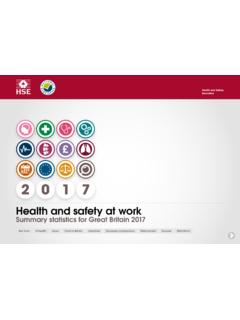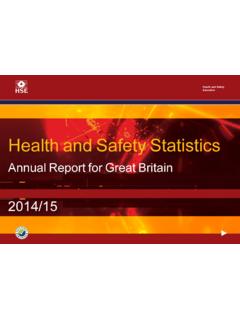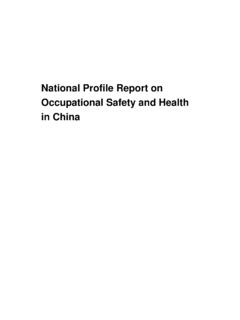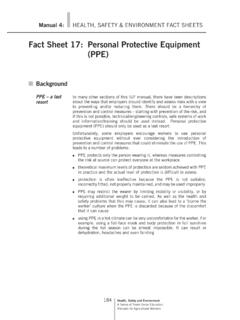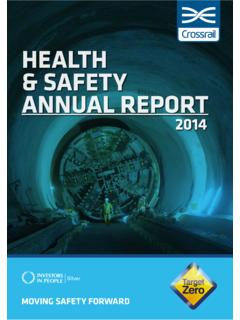Transcription of December 2015 The quest for meaningful and accurate ...
1 1 Dino Drudi Drudi is an economist in the Office of safety , health , and Working Conditions, Bureau of Labor quest for meaningful and accurate occupational health and safety statisticsTo help mark the Monthly Labor Review's centennial, the Review invited several producers and users of BLS data to take a look back at the last 100 years. This installment of the anniversary series comes from the Bureau's occupational safety and health statistics (OSHS) program. The Bureau of Labor statistics collects and publishes data on occupational injuries and illnesses. The OSHS program administers these efforts and has evolved for the purpose of collecting more accurate and complete data. Over time, this evolution has required a variety of changes, including new classification systems, recordkeeping procedures, injury and illness categorization, data collection methods, and coding much of its 130 year history, the Bureau of Labor statistics (BLS)1 has collected data and published reports on occupational injuries, illnesses, and fatalities.
2 From the beginning, BLS has engaged in ongoing efforts to improve the breadth and accuracy of the data available for end users. As far back as 1912, the occupational safety and health statistics (OSHS) program published annual reports on work injuries and Two of the more recent annual reports are from the Survey of occupational Injuries and Illnesses (SOII), which began with publishing 1972 data in 1974,3 and the Census of Fatal occupational Injuries (CFOI), which began with publishing 1992 data in The SOII covers nonfatal work-related injuries and illnesses, and the CFOI covers fatal work-related injuries. In 2013, the SOII estimated that there were 3,007,300 occupational injuries and illnesses among private industry workers, a rate of per 100 full-time equivalent workers. This was down from a rate of a decade earlier. Likewise, CFOI data identified 4,585 fatal work injuries in 2013, down from 5,575 in 2003.
3 BLS is continually improving collection methods to ensure that occupational injury, illness, and fatality data are accurately OSHS program has seen many new developments. The program has adapted to changes to the structure of jobs among American workers moving from field to factory to office and changing workplace safety regulations. This article updates an earlier article that traced the origins of the OSHS program from shortly after the founding of BLS in The first section offers a recap of the history of the OSHS program. The next two sections discuss December 2015 BUREAU OF LABOR STATISTICS2 MONTHLY LABOR REVIEW broad changes to the program, including updates to the classification system and revisions designed to ensure more complete data collection. The next section examines specific changes, including the addition of ergonomic injuries and illnesses, the expansion of data to include a wider scope of government workers, and the rise of job transfer or restriction-only cases.
4 Finally, this article discusses changes brought on by technological advances, including Internet data collection and computer-assisted has tracked workplace safety throughout its history. The timeline for this effort can be divided into three distinct periods. The first period covers the time before the to passage of the occupational safety and health Act of 1970 (OSH Act). The second period covers data collection under the OSH Act from 1970 through 1992. And the third comprises data collection efforts under program revisions, undertaken pursuant to a National Academy of Sciences (NAS) study, from 1992 through the 1970 Since 1894, BLS has published extensively on new developments in state and foreign social legislation and practices, including accident prevention and workers' In the years preceding World War I, BLS began to give special attention to industrial accidents and occupational diseases. In 1909, BLS published a study of phosphorous poisoning in the match-making During that time, BLS reported on lead poisoning, railway incidents, mining fatalities, and other safety and health topics.
5 In 1912, BLS issued its first annual report on injury rates in the iron and steel A few years later, cooperative arrangements with Massachusetts, New York, and Ohio were established for reporting industrial accidents;9 additional states would later join the 1926, BLS has produced an annual survey tracking the frequency and severity of industrial injuries for several manufacturing industries. This survey included data compiled from state records, as well as reports from establishments in targeted By 1930, BLS data covered a quarter of the workforce in some 30 manufacturing Nine years later, occupational fatality data were passed workers compensation laws in the 1910s generally required employers to record occupational injuries. These state records offered data collectors a much broader and more accurate source of work-related fatality statistics . However, because reporting standards differed from state to state, researchers continued to lack a uniform, comprehensive system from which to gather data at the national , the enactment of workers compensation statutes may have hindered development of national occupational injury and illness statistics , because many policymakers believed that these laws had largely eliminated the These concerns continued until passage of the OSH Act in World War II, BLS published monthly injury data for industries of particular wartime importance.
6 Because industrial incidents could adversely affect production, government agencies relied on these data to identify industries and establishments with high injury rates. After the war, BLS expanded its survey of injury frequency and severity by adding more manufacturing industries and including nonmanufacturing industries as well. By 1966, more than 650 industries were included in the Throughout these early studies, the biggest obstacle preventing researchers from accurately counting occupational injuries and illnesses was the lack of comprehensive, uniform data sources. BUREAU OF LABOR STATISTICS3 MONTHLY LABOR REVIEW 1970 92 The OSH Act (OSH Act) of 1970 required that states develop and maintain an effective program of collection, compilation, and analysis of occupational safety and health statistics . 16 The act established the occupational safety and health Administration (OSHA), as well as national definitions and recordkeeping standards.
7 Under the OSH Act, employers must maintain accurate records of workplace injuries and act required employers, when selected to participate in the annual survey, to report workplace incidents to In the past, such reporting had been optional. Since 1973, the SOII has published data on incidence rates for occupational injuries and illnesses in the private sector. These data capture both the private sector overall and specific private sector industries. Figure 1 presents overall private sector data from 1975 through 1976, BLS developed procedures to examine workers compensation records for additional information on injured workers and case characteristics associated with work-related injuries and illnesses. Out of these procedures came the Supplementary Data System (SDS), a comprehensive effort to standardize injury and illness data. By 1982, the SDS included 34 participating states. Data from state workers compensation systems met many data needs not fulfilled by the annual survey.
8 Still, individual states varying definitions of industries, workers, and cases covered made interstate comparisons difficult and national aggregation of state data 1977, BLS initiated a series of direct studies of injured Data for these reports, called Work Injury Reports (WIR), were acquired by mailing questionnaires to injured and ill workers in states participating in the reports provided detailed information on the causes and effects of selected workplace injuries and 1984, Congress appropriated funds for the NAS to study the accuracy and completeness of BLS occupational injury and illness statistics . The chief criticism was that, despite improvements like the SDS and WIR, BLS data shed little light on the characteristics of injured and ill workers. The NAS also found that BLS offered little BUREAU OF LABOR STATISTICS4 MONTHLY LABOR REVIEW regarding the circumstances of individual incidents. Important information about the nature of the injury or illness, how it happened, and the specific kind of job involved was often missing.
9 Moreover, the NAS found sampling error rates for estimates of work-related fatalities to be too high. In response to these concerns, the occupational injury and illness statistical program was presentSince 1992, OSHS has produced three annual products, as follows:Counts and rates of nonfatal occupational injuries and illnesses by detailed industry and case type (SOII summary data)Case circumstances and worker demographic data for nonfatal occupational injuries and illnesses resulting in days away from work (SOII case and demographic data)Counts and rates of fatal occupational injuries (CFOI data)While these outputs continue to provide comprehensive information on worker safety and health , BLS has introduced a number of program improvements in recent years; additional improvements are constantly being 1992, the SOII was restructured to provide data that had escaped BLS systematic collection efforts in the past.
10 The restructured survey added characteristics about workers whose injuries and illnesses required time away from work. The survey gathered more detailed information about the circumstances of the specific injury or illness: new detail on what happened and how it happened; the physical characteristics of the injury or illness; and the equipment, materials, tools, or substances involved. The survey also collected detailed demographic information on injured or ill workers, including occupation, age, gender, race or ethnic origin, and length of 2 provides median days away from work for selected age groups during 4 selected years 1992 (the first year in which the redesigned survey captured age data), 2001, 2002, and 2013 (the most recent year available). BUREAU OF LABOR STATISTICS5 MONTHLY LABOR REVIEW To improve the accuracy of workplace fatality data, the NAS recommended that BLS compile a universe of In 1992, in response to this recommendation, BLS launched the CFOI.











